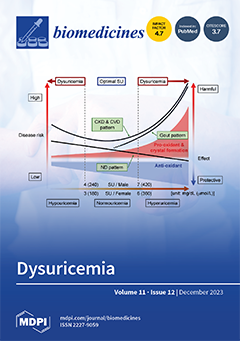Oxidative stress has been proposed as a significant part of the pathogenesis of fibromyalgia, and the phase angle in bioelectrical impedance analysis has been explored as a potential technique to screen oxidative abnormalities. This study recruited 35 women with fibromyalgia and 35 healthy women, who underwent bioelectrical impedance analysis and maximum isometric handgrip strength tests. Women with fibromyalgia showed lower bilateral handgrip strength (right hand: 16.39 ± 5.87 vs. 27.53 ± 4.09,
p < 0.001; left hand: 16.31 ± 5.51 vs. 27.61 ± 4.14,
p < 0.001), as well as higher body fat mass (27.14 ± 10.21 vs. 19.94 ± 7.25,
p = 0.002), body fat percentage (37.80 ± 8.32 vs. 30.63 ± 7.77,
p < 0.001), and visceral fat area (136.76 ± 55.31 vs. 91.65 ± 42.04,
p < 0.01) compared with healthy women. There was no statistically significant difference in muscle mass between groups, but women with fibromyalgia showed lower phase angles in all body regions when compared with healthy control women (right arm: 4.42 ± 0.51 vs. 4.97 ± 0.48,
p < 0.01; left arm: 4.23 ± 0.48 vs. 4.78 ± 0.50,
p < 0.001; trunk: 5.62 ± 0.77 vs. 6.78 ± 0.84,
p < 0.001; right leg: 5.28 ± 0.56 vs. 5.81 ± 0.60,
p < 0.001; left leg: 5.07 ± 0.51 vs. 5.69 ± 0.58,
p < 0.001; whole body: 4.81 ± 0.47 vs. 5.39 ± 0.49,
p < 0.001). Moreover, whole-body phase-angle reduction was only predicted by the presence of fibromyalgia (
R2 = 0.264; β = 0.639; F
(1,68) = 24.411;
p < 0.001). Our study revealed significantly lower phase angle values, lower handgrip strength, and higher fat levels in women with fibromyalgia compared to healthy controls, which are data of clinical relevance when dealing with such patients.
Full article






